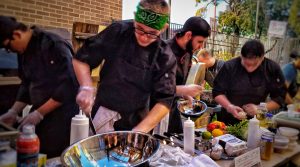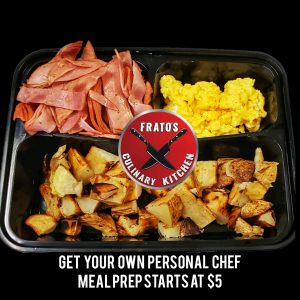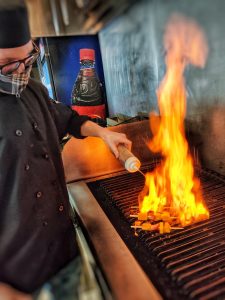Michael Kudrna, owner of Frato’s Culinary Kitchen in suburban Chicago, isn’t just experimenting with direct sales and virtual concepts to survive the pandemic. He’s also working with culinary students to provide real-world experience that’s not part of most culinary coursework. His team has found success with virtual brands and grassroots marketing, but Kudrna is skeptical about virtual restaurants over the long term, even as he continues experimenting with this latest restaurant industry gold rush.
With some students that are just 19 or 20 years old on their way to “learning a level of maturity and control and responsibility that they wouldn’t get anywhere else,” Kudrna goes much further than teaching the basics of food prep and presentation. Tying into his focus of building vertically to future proof his business, the independent owner-operator in Schaumburg, Illinois, empowers his students to create, test and launch their own virtual brands and menu items.

Frato’s Young Chefs in action at Culinary Fight Club.
Because the modern restaurant business is about more than good ideas and tasty dishes, Kudrna’s apprenticeships include details like costing and kitchen complexity, along with the importance of branding for his company’s marketing efforts and also for their own budding careers as future chefs and restaurant owners.
One of several Frato’s partnerships is with the nearby James B. Conant High School where students, working in teams or individually, compete in the Culinary Fight Club competition to create a new menu-worthy pizza, taking into account food costing and kitchen complexity. Once two finalists are chosen, the restaurant hosts a special event where customers vote to select the winning pie that lands on the menu for six months.
“I like building something and seeing other people helped from it, it’s self-motivating,” Kudrna said of the program, adding that many students eventually become employees. “My students like to stay, and I have the lowest turnover of any restaurant, probably, in the entire nation.”

Frato’s Artisan Bakery Boxes
Already experimenting with virtual restaurants before the dawn of the pandemic, Frato’s has launched a raft of delivery-only concepts including Cheesy Deliciousness, Heavenly Shakes, Halal Kitchen, Tenderlicious, Date Night, Que Pasta and Frato’s Bakery, which is a delivered and mail-order bakery brand that has become its most successful virtual property to date. Its operations are overseen by Chef Baker Tim Knilans, who happens to be a former pizza contest winner.
Frato’s had a catering operation before the pandemic, but like most restaurants, its volume of corporate orders is a shadow of its former self. Kudrna still sends students out on catering cold calls to drum up orders, which he sees as essential training.
Not waiting for catering to recover, the company has turned a portion of its focus to virtual restaurants and its meal prep initiatives in the meantime. He sees these delivery-only concepts as a fleeting rage in the industry, but uses them as a way to keep staff busy during slow days and between the busy lunch and dinner rushes at his quick-service restaurant. Overall, he questions the economic model of most virtual restaurants, especially when delivered by delivery services taking their own generous cut.
“My question is, is there actually gold? Are they going to actually find gold” Kudrna asked about the rise of virtual restaurants. “I’m confident they’re not. Any examples are either very short lived and we don’t know the long term yet, or they’re really not as successful as they’re claiming.”

Frato’s owner sees meal prep as a bigger opportunity than VRs.
The company has worked with Chowly, which is also based in Chicago, to integrate its virtual restaurants into its existing systems, so operations haven’t been a primary challenge. Kudrna said seamless order integration is the key for experimenting in virtual restaurants without creating operational challenges for the staff. As he and his young team keep testing new ideas, he doesn’t see virtual restaurants becoming a primary growth channel for his operation or independent restaurants as a whole.
“They’re being sold something that I don’t believe is actually going to help them other than very temporarily, and then they’re going to look back and see what their investment was versus what their overall payback was and realize this was just a novelty,” he added. “There’s a lot of small-business owners who don’t know their numbers and they’re going to get taken advantage of.”
Thus far, Frato’s has resisted the urge to spend money marketing his company’s virtual concepts. Asked why, as so many virtual brands pay to establish traction, Kudrna said “the whole concept is Grubhub’s supposed to market for me, that’s why they’re taking all that money from me.” In the coming months, he expects to change out virtual brands and continue trying new concepts to keep customers interested, especially as pandemic fatigue keeps growing.
Problem solving in action
After years of working to build and boost its native ordering channels, Kudrna estimates 70 percent of orders are coming into the restaurant through its own platform. The company uses DoorDash and Uber Eats to fulfill those in-house orders, and uses his own in-house drivers to fulfill incoming Grubhub orders.
To get around restrictions from third-party providers on marketing its native ordering, Frato’s gives customers the option of adding a free coupon to their order, which includes marketing copy designed to move customers away from the delivery marketplaces as much as possible.
“It’s just basic problem solving, it’s the core philosophy of what we teach here,” he said.
Frato’s new Clean Eats Kitchen meal prep brand is another part of its plan to diversify and future proof the business. Available for customers in the Chicagoland area, Kudrna sees this category becoming an even larger sales driver than virtual brands. Describing what he characterized as the Instagram effect, he sees this channel as the ideal complement as online influencers expand their audiences and monetize them with products, special diets and recipes.

Chef Andy Opiela prepares a catering order for a baby shower.
Its meal prep offerings focus on fitness junkies, as well as a more general audience. Frato’s brands its meal prep service as a personal chef, offering a free consultation with a chef to go over customers’ unique dietary needs and guidelines, including fitness-focused diets. The company is currently relaunching its meal prep offerings to include home delivery after initial tests showed more customer interest than expected.
Being able to sell and deliver meals directly to consumers with his meal prep arm means those orders completely sidestep the burdensome commissions charged by third-parties, he added.
Looking ahead, Kudrna predicts that both meal prep and catering will explode as the pandemic recedes, especially since many of the company’s catering competitors closed their doors over the last year. He also pointed to studies showing that younger consumers prefer to eat fewer large meals and more snacks than previous generations.
“Everything is working towards meal prep and restaurants can easily convert if they have the right processes in place to handle meal prep,” he said. “If I’m paying somebody $15 an hour and I don’t have enough volume all day to sustain their … wage, I have to start cutting or I have to find other revenue streams. I’ll take a revenue stream that Grubhub isn’t taking from me.”


